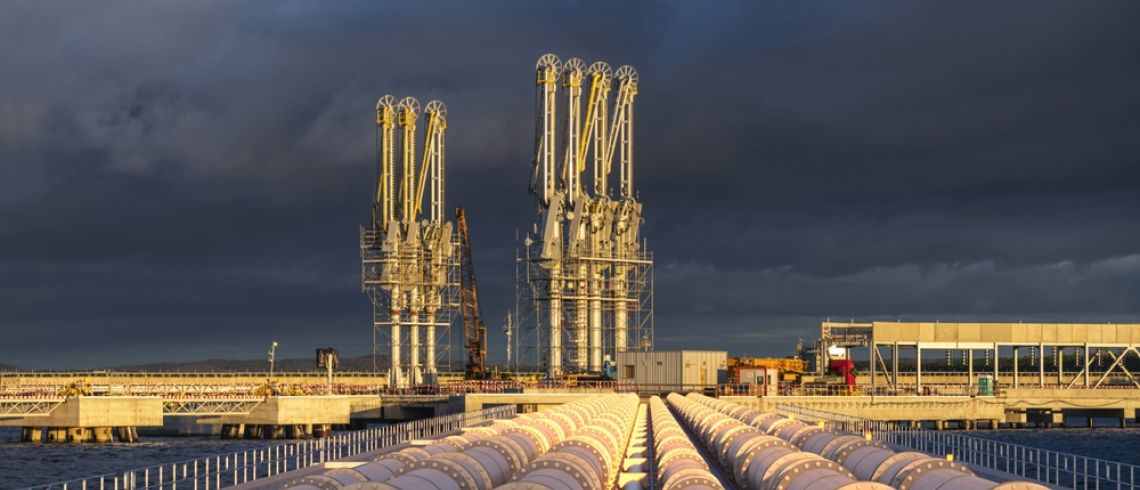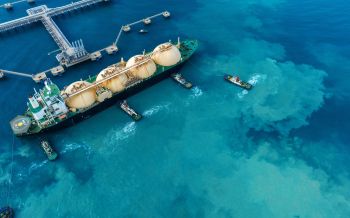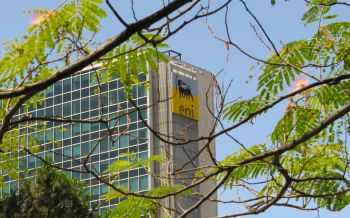LNG demand is set for growth in the coming years, not least of all due to COP28’s commitments to a phase-out period for fossil fuels and the push to wean the world off Russian supplies.
The US will take centre stage as a top exporter. However, for new developers of LNG export capacity in the US, the growth brings uncertainty too over a myriad of factors – from rising capex costs and investor concerns over fossil fuels, to Europe’s division over spot market volatility risks and reluctance to signing long-term agreements.
Vivek Chandra is navigating through such issues as CEO of Gulfstream LNG Development. The company is charged with one of the new terminals being developed: the 4 million tonnes per year Gulfstream LNG export project, based in Plaquemines Parish, Louisiana. Permits were secured from the US government earlier this year and agreements – with Baker Hughes, Honeywell and Kiewit Energy Group to provide liquefaction and gas treatment technology and supply engineering, procurement, and construction (EPC) support – freshly inked in November.
With his 30-year history in the LNG industry, Chandra brings a depth of knowledge to the top role, which includes his start as a geophysicist and his work as an offshore oil rig engineer in Southeast Asia.
But it was a 2013 presentation from Cheniere, “which for the first time showed details of an export company’s LNG contracts and prices” that shifted Chandra to develop an independent LNG export project.
“The US is unique in that respect, as it’s the only market where you can build an export terminal without directly owning any upstream gas assets, you just need access to pipelines to buy gas on the wholesale market,” he told LNG Business Review.
He picked Brownsville, Texas for his first export project, Texas LNG.
“At the time, there was plenty of land and deepwater access, but no gas pipelines in the area. We expected and were correct in assuming that pipelines linking Brownsville with producing basins in Texas would be built,” he said.
The project was developed as part of the early wave of US LNG. Chandra took it through its multiple fund-raising equity investment rounds, the FEED process, and the entire permitting process. The company was sold in 2019, with Chandra in situ as CEO until 2022. He remains a significant shareholder.
In the rest of the interview, in full below, Chandra discusses the challenges of securing financing for the project amid expectations that LNG will remain central for energy security for decades to come.
What’s the latest update on the development of a second export terminal, Gulfstream LNG?
We’re currently in discussions with investors around the world in order to raise funding. We have a great deepwater site, an export permit granted by the US government, and we recently announced deals with technical partners which are experienced in building projects in Louisiana. Once we secure these initial investments, we’ll start the permitting process which we expect in the next few months.
February 2022 marked a dramatic change in European gas markets, and thus a major moment for US LNG, as the world realised there’s a massive need for American gas. There continues to be a perception that there’s more incremental US LNG that will be available in the coming decade than actually is. However, the fact remains that there are few, if any ‘permittable’ sites left in North America.
Qatar and the US are going to be adding around 170 million tonnes of gas to the market in the coming years. Projects outside these two major countries are usually quite small and won’t move the needle. The global market, in my view, is structurally very short looking beyond 2029. For example, every coastal country in Asia are looking to increase or to commence LNG imports. The same situation is present in most countries in South America as well as Europe. There are also an increasing number of countries in Africa and Middle East looking to import LNG.
Demand is projected to incrementally grow by at least 250 million tonnes globally by 2030.
At the same time, raising funding seems harder this time around than the first time. I think that’s because a lot of the first wave of US LNG was funded by European investors, which are stuck between publicly stating that they cannot invest in LNG due to their prior net-zero commitments, but privately they wish they could invest to secure their long-term supplies which are getting harder to procure.
Only when they can reconcile their public and private persona then we will see financing unlocking for new projects.
The current uncertainty is causing confusion in the investment community.
And while it’s true that there’s growing interest from Middle East capital towards LNG projects, that tends to go towards big brand names, they rarely support start-ups. It would be nice to see large funds and companies from the Middle East support independent projects such as Gulfstream LNG, as history has shown that we independents are better at project delivery than many big brand names.
Other investors such as infrastructure funds have pivoted towards hydrogen and other ‘esoteric’ fuels…I think many of these project plans will collapse within the next six to twelve months, when the realisation will come that many of their assumptions on declining costs and rising demand were based on unrealistic assumptions. We should move past these distractions and, instead, we should focus on low carbon fuels such as LNG. By moving our focus away from LNG, we are actually encouraging more coal power development as LNG costs and supplies are not growing enough to meet power demand.
Many renewable and low-carbon projects were based on expectations that Capex is going to get cheaper and cheaper…That’s a false hope in my view and largely dependent on China to play along. This is not at all certain.
I had investors who decided to pull money at the last minute in order to invest in hydrogen and wind.
On the other hand, LNG projects are having a hard time getting to FID, many pre-FID projects have not done good for their investors and this record may have negatively impacted the credibility of new projects.
One example of that is Venture Global and their endless stream of commissioning cargoes. How can buyers trust new LNG export projects moving forward?
I’m concerned that the Venture Global squabbles might ruin the hard-earned credibility of US LNG…But at the same time, US LNG is a history of success, we’ve delivered more volumes with less drama that any other export countries, for example Australia where not a single one has delivered within budget and timeframe. We will move past this as more projects get delivered and US LNG shows it can be a reliable, low-cost supplier of LNG.
There’s also the issue of countries like Pakistan having to switch back to coal because the cargoes they had contracted were being sold on the more lucrative spot market instead…
Expensive LNG pushes countries such as Pakistan and others, such as India and even China, back to using coal. Meanwhile we’re telling them they should look at ammonia and hydrogen as alternatives…That makes little sense when they need lots of affordable energy and we should do all we can to encourage them to use clean energy, but it has to be affordable and available for them.
What we should be doing instead is subsidising LNG and encouraging more LNG supplies to make it more affordable.
Reducing operational emissions has become a focus for investors who expect best-in-class technology. What solutions are you implementing in that respect at Gulfstream LNG?
The methane pledge recently announced in the US is a great thing, we should have done it a long time ago, and sets America as a leader in reducing flaring. This commitment can significantly help reduce upstream emissions and thus overall emissions on our exported LNG. At the same time, we’re looking at running the Gulfstream LNG facility with electricity in order to further reduce emissions.
READ COP28 deal sees role for ‘transitional fuels’ and CCS
The project is also located in Louisiana near salt domes with lots of nearby depleted fields which opens up carbon storage opportunities.
Have you signed any deals?
One of the learnings that came from Texas LNG is that there’s no point in signing off-take customers early. Capex changes rapidly, and it’s a fallacy and fool’s game to be out there looking for off-takers. We need to begin the permitting and engineering process, which requires equity investors first, some of whom might also want to be off-takers.
Gulfstream LNG plans to serve domestic, regional, and international LNG markets via river barges, small ships, bunkering vessels, and large tanker exports. Could you elaborate on your business model?
While most export projects in the US are targeting shipping gas overseas on large ships, we see a massive growing market for LNG bunkering and smaller cargo deliveries in the Caribbean, Central America and South America.
At the same time, the existing large LNG exporters in the US do not have the infrastructure in place to serve this market and do not have the permits to easily add these facilities to their existing plants.
We have an export permit of 4 million tonnes per year, and we expect that as much as 1 to 2 million tonnes will be serving the regional market.
We also plan to service the LNG for domestic road transport market in the future, although at the moment that’s still nascent.
Is there a risk that export prices might rise in the future amid a lack of pipeline development domestically which might impact availability of gas from the lowest cost gas fields?
We are not concerned by this as we have a regional pipeline grid that is under-utilised and there’s a lot of new pipeline capacity that is being expanded that can carry Haynesville gas to our site.
What other major risks do you see for US LNG, such as increased competition for manpower, cost increases and overrun risks?
Capex is cyclical and we have years ahead of permitting. It’s hard to expect what the future labour situation will be.
You were previously vocal about European buyers not signing enough long-term contracts. What’s the outlook for Europe now?
We need more commitments. We’re not seeing enough off-take deals. Only when off-takers are willing to sign long-term commitments can projects such as Gulfstream LNG raise funding to go through the expensive permitting and technical development processes.
This year there haven’t been enough contracts being signed, and that’s why a lot of projects are stuck at FID. The buyers in Europe, Asia have not reconciled the high spot price with their desire for a low long-term price.
If we want more LNG, customers have to accept a higher price
A number of projects are 80% sold but cannot get to FID as their Capex and interest costs have risen dramatically, and many of their off-take customers have not accepted that this has to result in an increase in the LNG price.
If we want more LNG, customers have to accept a higher price. This higher price is still much lower than the spot prices that they are reluctantly accepting at the moment.
What role do you see for gas in the future and how climate talks impact that outlook?
I think gas is going to very much be the fuel of the future. We had a distraction in the past few years thinking that other low-carbon fuels will be there. As long as we need a portable, efficient, affordable fuel that has much lower emissions compared to coal, LNG is a great fuel, and definitely a bridge and possibly more than that. Remember that transitions don’t happen overnight, we were supposed to have transitioned away from coal 30 years ago, but we’re now using even more coal than before. - BB
Subscription Benefits
Our three titles – LNG Business Review, Gas Matters and Gas Matters Today – tackle the biggest questions on global developments and major industry trends through a mixture of news, profiles and analysis.
LNG Business Review
LNG Business Review seeks to discover new truths about today’s LNG industry. It strives to widen market players’ scope of reference by actively engaging with events, offering new perspectives while challenging existing ones, and never shying away from being a platform for debate.
Gas Matters
Gas Matters digs deep into the stories of today, keeping the challenges of tomorrow in its sights. Weekly features and interviews, informed by unrivalled in-house expertise, offer a fresh perspective on events as well as thoughtful, intelligent analysis that dares to challenge the status quo.
Gas Matters Today
Gas Matters Today cuts through the bluster of online news and views to offer trustworthy, informed perspectives on major events shaping the gas and LNG industries. This daily news service provides unparalleled insight by drawing on the collective knowledge of in-house reporters, specialist contributors and extensive archive to go beyond the headlines, making it essential reading for gas industry professionals.






